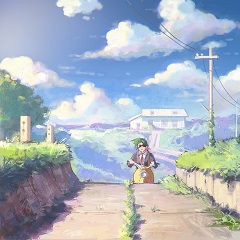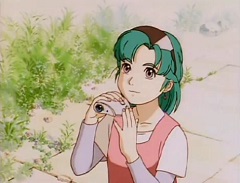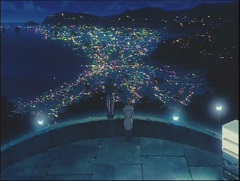 \\
\\Yokohama Shopping Log
More often than not, when an anime takes place in a post-apocalyptic world its characters are locked in a battle to survive. There are ruins everywhere and they're guaranteed to be crawling with mutants of some sort that are eager to wipe out whatever remains of the human race. Things are bleak, there's a sense of loss, and the stories focus on humanity trying to dig itself out of the hole it has gotten into.What makes Yokohama Shopping Log so interesting is that while it also happens during the end of the world, it takes all of these ideas and tosses them out the window. The OVAs are brief excerpts from a manga series published in Afternoon magazine from 1994 to 2006. It follows the day-to-day life of a robot named Alpha who is running a coffee shop on the outskirts of Yokohama. At some point, her owner went away and hasn't come back since, leaving Alpha to dutifully run the place in his absence. It's rare that she has a customer.
As we watch Alpha go about her day, we see the show present the world simply as being the way things are. Sea levels have risen and much of Yokohama is now submerged under water, forcing the remaining humans to settle in the surrounding hills. All around, the streets and buildings are slowly falling into decay and being overtaken by vegetation. Meanwhile, the old street lights turn on every night as a reminder of the civilization that was once there.
All of that being said, there isn't any sense of impending danger. It's just the way things are and it feels like humanity has accepted their fate and will gracefully, gradually fade from the face of the Earth. There isn't even a sense of discomfort from the viewer's perspective. Instead, one simply has a relaxed feeling of acceptance that this the way things will go and it's totally natural. If anything, there is a constant underlying sense of nostalgia, thinking back to how things used to be as they slowly go away.
Even the art and music accentuates this. Colors are soft pastels while there are few sharp lines anywhere to be seen. What it provides is a warm, inviting world, not the bleak, gray hellscape so commonly portrayed at the end of the world. Meanwhile, music is largely light, jazzy tunes that makes situations feel relaxing. More importantly, it doesn't overstay its welcome. In the first OVA, music is actually very sparse, showing up at the start and end of an episode and only briefly appearing in the middle, usually as a standalone song to emphasis a mood.
There are actually two OVAs, and they were released several years apart. The first came out in 1998 with the follow-up coming along in 2002/2003. Both provide brief glimpses into the world presented in Yokohama Shopping Log, and it's hard not to wonder if the OVAs' producers faced a similar challenge to Alpha when she received a camera from her owner. Did they think long and hard about what stories to focus on that best captured the essence of the manga's world, just as Alpha puzzled over when to take the perfect photograph to capture the essence of the world fading in front of her? What the OVAs showed of the world was certainly interesting, and will likely get more than a few people tracking down the manga itself.
Usually post-apocalyptic anime has a bleak tone as everyone fights to survive. Yokohama Shopping Log, on the other hand, is the most relaxing, inviting, nostalgic end of the world scenario that one might ever encounter. It encourages the viewer to sit down, have a cup of coffee, and enjoy watching humanity slowly fade away.
- IroIro
March 15, 2019
Hitoshi Ashinano
Director: Takashi Annou
Studio: Ajia-do Animation Works
Released: 1998
Episodes: 2

Alpha riding her scooter

Her camera becomes very important to Alpha

Much of Yokohama is submerged